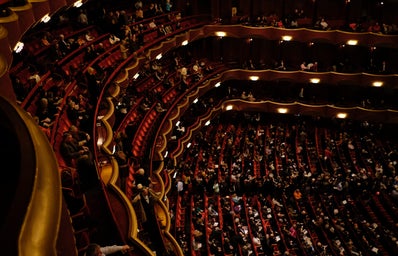Do you ever just go to the movie theater one day and watch something that you knew you were going to like but didn’t expect to have such a gut-wrenching reaction to how much you actually liked it? That was “1917” for me. It’s no wonder why it won a Golden Globe for Best Drama this year.
“1917” is a fantastic film with masterfully crafted cinematography, superb editing, captivating actors, and a story that will make your eyes filled with so many tears that you can fix any drought in the world. It’s a war movie that perfectly captivates what war is and how it affects those involved in it. The story is a fairly simple one. Two soldiers, Will Schofield (George MacKay) and Tom Blake (Dean-Charles Chapman) are ordered to send a message to a British battalion to call off an attack that is planned to occur the next day. The battalion believes that they have the Germans on the run when in actuality, it’s a “tactical retreat” meant to place the British battalion in a trap. If the battalion were to attack, the British army could potentially lose 1,600 men, one of them being Blake’s older brother.
Picture via The National Archives
Original Caption: Trenches where American soldiers started to dig in on the first night of the St. Mihiel drive and then they went 5 kilos further. Beney is seen in the center in the distance. Near Beney, Meuse, France. September 25, 1918. Local Identifier: 111-SC-25287
It’s a fairly basic story: get to the battalion in time, give them the message to call off the attack, don’t get caught or killed by enemy forces, and do it in less than a day. It’s simple, but the execution of it is amazing. The first thing that one may notice is that the movie appears to be done in one shot with no cutaways. This really makes the audience feel the passage of time as if they’re really there. There are scenes that take place in the middle of the night and then, out of nowhere, you can see the sky transition from night to day. This technique also means that you can only focus on one thing at a time. Think of something like the original “Star Wars” movie when Luke is about to destroy the Death Star. In those couple of moments, we see Luke firing the missiles, Leia looking anxious at the rebel command base on whether or not they’re about to be blown up, imperial officers prepping the Death Star to fire, and the remaining rebel fighter ships flying away to safety before the Death Star explodes. “1917” doesn’t give you the luxury of being an almost omnipresent observer. We can only focus on what we are currently focusing on right at that moment and to change that focus, we must direct our attention somewhere else. Literally, we need to change the direction our lens is facing, like a camera. “1917” manages to use this as one of its biggest strengths. We, the audience, have just as much clue of what is going to happen next as the main characters do. Simply changing the perspective of the camera can change the perspective of the scope of the war or change how we see the insurmountable odds that are placed in front of Schofield and Blake. And that’s only scratching the surface of the cinematography.
Aside from the fact that “1917” creates a successful illusion of a one-shot movie, the imagery is something else entirely. There is a scene that takes place in a small, French town in ruins due to the destruction of the war. The village is occupied by German soldiers patrolling the grounds. When we arrive at this point, it’s nighttime and the only light the burning of the village that hasn’t already been destroyed, which we see in the far off distance. Then, flares from unknown sources start to go up in the night sky and light the world around it. What was once in shadow comes into the light and the light falls back until the flare burns out. The shadows move due to the changing light source on the bricks and stones of the ruins. We see a different perspective on the village, except instead of the camera, it’s the lights that change our view. This is a beautiful scene and truly is a spectacle of awe and wonder.
Picture via The National Archives
Original Caption: Members of the 107th Infantry, 27th Division, on guard at old French chateau. East of St. Souplet, Nord, France. October 19, 1918. Local Identifier: 111-SC-31875
The movie also does a great job of addressing war itself with its own perspective about war. I can’t get into it without spoiling some stuff which I really don’t want to do for anyone who hasn’t seen it so please, if you haven’t already, go watch it.
Okay, have you seen it? Didn’t I tell you it was good? Alright. let’s continue. When it comes to war movies, they usually fall into one of two categories: war glamorization (think “The Patriot”) or anti-war (think “Apocalypse Now”). “1917” falls into the latter. War is seen purely as governments dragging their own people into the conflict, regardless of their willingness to fight. Our protagonists Blake and Schofield discuss this throughout the film. It’s easy to miss but in the beginning, Blake reveals that he hasn’t been in the front for as long as Schofield has. When Blake receives orders from command, he’s filled with determination to succeed. Schofield, on the other hand, has already seen the horrors of war and simply having to cross the dreaded No-Man’s-Land is terrifying enough. Blake is fully faithful to the commanders, the ones who don’t have to actually be in the front lines and experience the same extent of pain and suffering. Blake’s blind faithfulness even leads him to believe that he would be back just in time for Christmas, which was the popular belief of soldiers at the start of the war. Schofield isn’t as sympathetic, having been over No-Man’s Land, which didn’t end well (besides for getting a sweet medal). Again, all of this is easy to miss because it’s quickly said in the beginning and never addressed again (especially if you’re American trying to understand a British accent.
Blake is a personification of how war was seen before the start of World War 1 and Schofield, his foil, is the personification of the reality of war in the 20th century. This is seen when Blake notices that Schofield isn’t wearing his medal and asks why. Schofield eventually explains that he sold it for a bottle of wine. A somewhat disappointed Blake says that Schofield shouldn’t have done that and that he should be honored wearing that medal, as maybe it’ll be the last thing his family will ever receive from Schofield. Schofield retorts by saying that the medal is just a piece of tin and it’s not worth dying for. In fact, he’d rather be with his family and has already accepted his fate that he will never get to see them again. Schofield reflects a belief that being drafted into the war is the equivalent to a death sentence (which was a pretty accurate assumption for World War 1). Technology for mass killings was invented, such as the machine gun, the gas bomb, the tank, the flamethrower, and other kinds of fun murder weapons. If you got drafted, you were not expected to live, which is exactly what happened to Blake.
Picture via The Library of Congress
Blake dies less than halfway through the movie leaving Schofield to do literally the entire mission by himself. Ironically (and purposefully), Blake wanted to serve his country and was rewarded with a painful death, whereas Schofield didn’t want to participate in the war but becomes the reluctant hero of the story. Schofield succeeded in his mission, not for country or for his homeland, but for Blake, who we can assume was his closest friend in the war. But Blake dying and Schofield succeeding in his mission sends a greater message. War in the 20th century was a different beast from the wars previously. The perception of war as something that gives glory and honor to others was long over. The soldiers would much rather be at their homes enjoying themselves (which is universally relatable in all contexts) and use this end goal as a drive to fight. At the very end, it’s revealed Schofield has two daughters and a wife waiting for him. This was Schofield’s drive, and this isn’t the first time something like this has been shown in a movie before. “Saving Private Ryan” has a scene where Jon Miller, played by Tom Hanks, indicates that at the end of the movie before the final climactic showdown that he simply wants to go home to his wife.
Schofield does succeed in delivering the message and he saves others in the process, including Blake’s older brother. But “1917” throws all that out after Schofield delivers the message to the commanding officer of the battalion. The commanding officer, played by Benedict Cumberbatch, says one chilling line. “…next week, Command will send a different message. Attack at dawn (Mendes/Wilson-Cairns).” Schofield didn’t save anybody; he only delayed their demise. In one week or less, most or all of those men will be dead, and he can very well be among them.
Everything that Blake died for and Schofield suffered for was all in vain. Yes, the mission was a success and the battalion didn’t walk into a trap, but now their deaths have been moved to a later time in the war. So what did Blake and Schofield really accomplish? In the very beginning of the movie, the first scene is Schofield sleeping on a field while leaning on a tree with Blake lying on the ground next to him.. The final scene of “1917” is Blake slowly walking to a tree to get some rest after his exhausting mission. He sits on the ground and leans back on the stump as he did at the beginning of the movie, and the camera takes is positioned exactly like how it was at the opening scene except this time Blake isn’t with him. It all starts back at square one, except with fewer survivors and more dead.


